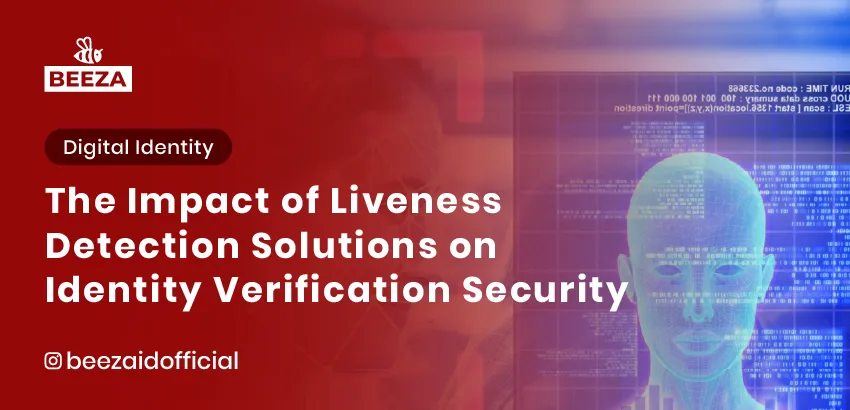
In today’s digital age, identity verification is a critical process across various industries including finance, telecommunications, and government services. With the rise of digital services, verification needs to be fast, accurate, and secure. However, the risk of identity fraud using conventional methods like static photos or videos is increasing significantly. To address this, liveness detection technology has been developed to ensure that the individual verifying their identity is genuinely present and alive during the verification process. This article explores how liveness detection enhances security in identity verification, its benefits, challenges in implementation, and future outlook.
What is Liveness Detection?
Liveness detection is a biometric technology designed to distinguish whether the subject being verified is a live human, rather than a photo, video, or mask. The system relies on several methods, including:
- Dynamic motion detection, such as asking the user to blink, smile, or turn their head.
- Skin texture and light reflection analysis to differentiate real objects from fakes.
- Infrared or 3D sensors to measure facial depth in real time.
This technology is an essential complement to electronic Know Your Customer (eKYC) and digital verification processes that require a high level of security.
How Liveness Detection Enhances Identity Verification Security
- Prevents Fraud with Photos and Videos
One of the most common fraud methods involves using someone else’s photo or video to create fake accounts, conduct unauthorized transactions, or steal identities. By detecting dynamic movements and physical features, liveness detection can accurately differentiate real humans from impersonators, significantly reducing fraud risk. - Ensures Real-Time Authentication
Verification accuracy improves because the system evaluates the user’s condition in real time, preventing the use of pre-recorded footage or static images commonly used to deceive verification systems.
Builds Trust and Regulatory Compliance
Regulations such as Anti-Money Laundering (AML) and Customer Due Diligence (CDD) require financial institutions to conduct stringent and accountable identity verification. Using liveness detection helps businesses comply with these regulations, avoiding legal penalties and boosting user confidence. - Speeds Up Customer Onboarding
Liveness detection enables automatic, fast verification without requiring in-person checks or manual processing. This improves user experience and reduces operational costs.
Real-World Case Studies of Liveness Detection Implementation
Bank Central Asia (BCA)
Bank Central Asia has integrated liveness detection technology into its mobile banking app as part of the eKYC process. This implementation helped reduce identity fraud cases by 40% within one year. Before liveness detection, manual verification took days, but now it only takes minutes, enhancing both efficiency and customer satisfaction.
Ovo
Ovo, one of Indonesia’s leading digital payment platforms, uses liveness detection to secure account registration and transactions. This technology reduces fake account creation and identity misuse, adding a critical layer of security in a highly competitive fintech market.
Additional Benefits of Liveness Detection for Businesses
- Operational Cost Savings
Automating identity verification reduces reliance on manual processes and human resources, cutting operational expenses. - Easy Integration with Other Technologies
Liveness detection can integrate seamlessly with other biometric technologies like facial recognition, digital signatures, and blockchain, creating a robust multi-layered security ecosystem. - Improved Customer Experience
Users can verify their identity anywhere using their mobile devices without visiting physical branches. A fast, seamless process increases customer satisfaction and loyalty.
Addressing Common Challenges in Implementation
While the benefits of liveness detection are clear, businesses must consider several challenges for successful implementation:
- Camera Quality and Environmental Conditions
Liveness detection accuracy depends heavily on the quality of user devices and environmental factors such as lighting and background noise. Solutions must be optimized to function reliably across diverse conditions and devices. - Privacy and Data Protection Compliance
Since biometric data is highly sensitive, companies must ensure compliance with data privacy regulations such as GDPR in Europe or local laws elsewhere. Secure encryption, anonymization, and controlled access to data are essential to maintain user trust. - Continuous Algorithm Improvement
Fraudsters are increasingly using sophisticated methods such as deepfakes or 3D masks to bypass security systems. Liveness detection algorithms need constant updates and improvements through machine learning to stay ahead of emerging threats.
The Future of Liveness Detection Technology
Looking forward, liveness detection is expected to become more intelligent and seamless, leveraging advances in artificial intelligence and sensor technology. Innovations such as:
- Multimodal Biometrics combining voice, fingerprint, and facial liveness detection will provide even stronger security.
- Passive Liveness Detection techniques that require no user interaction, making verification more user-friendly without compromising security.
- Integration with Decentralized Identity Solutions where users control their biometric data, enhancing privacy and reducing centralized risks.
These advancements will make identity verification safer, faster, and more convenient, fueling broader adoption in banking, healthcare, travel, and e-commerce.
Conclusion
Liveness detection technology plays a pivotal role in enhancing security during digital identity verification. By accurately detecting a live subject, it reduces identity fraud risks, accelerates customer onboarding, and helps businesses meet strict regulatory requirements. Case studies from Bank Central Asia and Ovo demonstrate the technology’s effectiveness in optimizing security and operational efficiency. While challenges exist, continuous innovation and adherence to privacy laws make liveness detection a vital investment for any business operating in the digital era.
💡 Ready to secure your identity verification process with advanced liveness detection technology? Contact Beeza for innovative, trusted solutions tailored to your business needs!